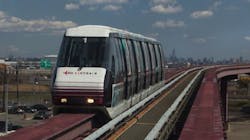PANYNJ publishes draft environmental assessment for AirTrain replacement at Newark Liberty International Airport
The Port Authority of New York and New Jersey (PANYNJ) has published the draft environmental assessment (Draft EA) for the AirTrain replacement project at Newark Liberty International Airport.
The Draft EA, an integral part of the AirTrain Newark Replacement Program, is required by the National Environmental Policy Act (NEPA). The Draft EA evaluates the potential environmental impacts of the project across 17 impact categories. No significant, permanent impacts were found in the categories assessed. Of the 17 impact categories assessed, the Draft EA identifies three potential, temporary impacts during construction and recommends corresponding mitigation measures.
“The Draft Environmental Assessment for the new AirTrain at Newark Liberty International Airport is a critical step forward in the process of modernizing one of the busiest travel hubs in the country,” said New Jersey Gov. Phil Murphy. “As we look forward to our post-pandemic future, strong and reliable infrastructure at our airports is of the utmost importance, and I am glad to see this project is progressing as it has been a focal point since early in my administration. I am grateful to our partners at the Port Authority for their commitment to improving the travel experience at New Jersey’s gateway to the world.”
The Draft EA and an overview presentation are available on the Port Authority’s website for public review and comment until March 12, 2021. The Federal Aviation Administration (FAA) is the lead federal review agency. The FAA will issue its findings on the final EA following the review and incorporation of public comments.
“As Newark Liberty’s frequent travelers know, the new AirTrain can’t come soon enough. The Port Authority is committed to delivering world-class infrastructure and a 21st century customer experience that includes a new AirTrain,” said Port Authority Chairman Kevin O’Toole. “We look forward to hearing the public’s input and advancing the project through the federal environmental review process.”
“The current AirTrain Newark has reached the end of its useful life, suffering frequent breakdowns and delays. A modern best-in-class airport must have an appealing, reliable best-in-class rail mass transit link that will eliminate headaches during travel, not cause them,” said Port Authority Executive Director Rick Cotton. “This new AirTrain system at Newark Liberty will complement the Port Authority’s $2.7 billion investment to replace Terminal A, currently underway, and serve as an important economic contributor to New Jersey and the region.”
The new AirTrain Newark will be a 2.5-mile elevated guideway train system and is a critical component of the modernization of Newark Liberty. It will replace the existing AirTrain, which opened in 1996 and is increasingly vulnerable to more frequent breakdowns and delays.
In addition, the new system will be designed to maximize customer convenience with seamless connections to other forms of transportation and provide modern wayfinding, digital tools and amenities in AirTrain stations and in vehicles. It will connect to the new 1-million-square-foot terminal, replacing the existing Terminal A, as well as the new consolidated rental car facility.
In January 2019, Gov. Murphy called on the Port Authority to act quickly to fund a new AirTrain system that would meet the world-class standards of the airport’s new terminal and the needs of the region’s travelers at Newark Liberty. In October 2019 the Port Authority Board, as part of the reassessment of the agency’s 2017-2026 Capital Plan, approved new project funding for a new AirTrain Newark.
AirTrain Newark is crucial to the airport’s operation. In 2019, the line carried an average of 33,000 passengers per day, or approximately 12 million passengers per year. It provides access to the Northeast Corridor Rail Link Station and assists customers and employees transferring between air terminals, parking lots and rental car facilities.
